Proven Solopreneur Business Scaling Strategies: How to Grow Your One-Person Business Efficiently
Discover proven solopreneur business scaling strategies to grow your one-person business efficiently. Learn how to use automation, outsourcing, and personal branding to achieve sustainable success.
BUSINESSTRENDS
Bogdan Antihi
9/18/2024
Introduction
Over the last few years, entrepreneurship has come a long way. Although brick-and-mortar businesses are most often associated with a team of employees, a new kind of entrepreneur — known as a solopreneur — is on the rise and managing all aspects of business alone. Solopreneurs own and run their business from idea to get done, using technology or outsourcing techniques like sell-off management to help them scale.
Solopreneurship is a growing trend within the broader societal movement towards increasing autonomy, technological developments and desire for more flexibility in career opportunities. Because of the rise of digital tools, remote work and gig economy platforms, it is possible for more people than ever to start and grow their own business without employees.
In this article, we will go deeper into the work of a solopreneur, cover how to start small businesses in general and provide some ideas and tools that you can use as well-ranking beginning entrepreneur. And we will dig into real-life examples showing how people are actually building successful solopreneur businesses.
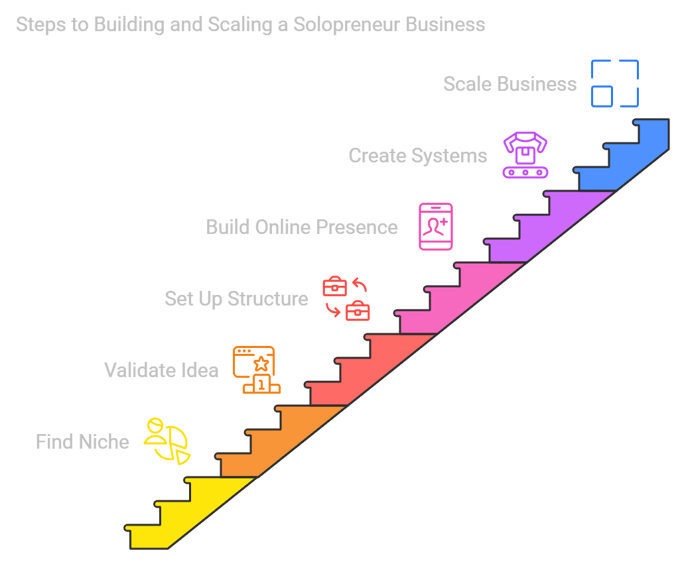

What is a Solopreneur?
A solopreneur is a person who runs a business by himself or herself and, in essence, does all the work of the organization without any employee. Traditional entrepreneurs usually develop teams or partnerships, but solopreneurs generally wear multiple hats—marketing through to customer services, product creation through to sales. While some solopreneurs remain solo indefinitely, other solo businesses eventually grow by outsourcing or automating certain tasks. A solopreneur is an entrepreneur who works alone, with the distinct concentration being on independence and autonomy over their business. Solopreneurs often work with contractors or freelancers, but they run the business themselves.
Why Solopreneurship is on the Rise
Clearly, technology is one of the driving reasons why solopreneurship has risen in recent years along with remote work becoming more acceptable and leaving the traditional job as less attractive.
Innovation in Tech
Digital products have transformed how business is done. Shopify, Etsy, and Fiverr have made it easy for solopreneurs to sell products as well as services without an actual brick-and-mortar store. You can use apps such as Slack, Zoom, and Trello to communicate and manage projects with your team of contractors and clients. Additionally, automating their work processes helps solopreneurs reduce the time wasted on mundane repetitive tasks and allows them to use their time for more strategic business growth.
Remote Work Takes Ground
The pandemic brought about a worldwide move to remote work, with millions of people turning part-time businesses into their home base. This then led to a great number of workers realizing they preferred the flexibility and independence that came with working as an independent contractor. This made for perfect conditions for solopreneurs as many more began to look at career choices beyond the constraints of the regular 9 to 5.
Seeking Independence
A lot of solopreneurs are motivated by a desire for independence — to be able to do things their own way, on their own time and preference. While traditional entrepreneurs might be seeking to build large businesses, solopreneurs typically invest in themselves and their lifestyle over a massive business.


The Benefits of Being a Solopreneur
There are multiple benefits to being a solopreneur over starting with a large team of your own or hiring a bunch of employees yourself.
Flexibility
As a solopreneur you have full control of your time and the work you can take up. You can work when and where you want, improving the quality of your work life. It is this flexibility that makes it extremely attractive to those people who wish to work online, be location independent and perhaps have a laptop lifestyle based around one's own passions..
Minimal Overhead Costs
Free from needing employees, offices and all the other typical business expenses, solopreneurs can start with very little costs. This means that solopreneurship is more available to more people due to the lower level of financial barrier to entry.
Agility
As the one calling the shots, solopreneurs have the agility to shift focus if market conditions or a new opportunity calls for it. They also skip the bureaucracy and game patching specific to how individual departments move at larger companies, making them more able to change quickly and create.
One on One Client Relationships
Solopreneurs usually have one-to-one contact with clients, able to form a real connection. This live interaction makes for great customer service and loyalty, as customers like the personal touch.
Personal Fulfillment
Solopreneurs derive pride in building a company that resonates with their purpose and passions. That control over every part of the business means solopreneurs can go the only direction that sounds right to them, one as unique as they want it to be.


Challenges Solopreneurs Face
Solopreneurship can be advantageous for multiple reasons but has its challenges as well. Here are the top challenges solopreneurs tend to encounter:
Time
Solopreneurs must play multi-faceted roles; whether it’s marketing, customer service, or accounting. With no group of people to do the work for you, time becomes essential. If you find yourself a solopreneur, it is important to set priorities and automate those processes that allow for a break.
Scalability
Scaling a one-person business is different than scaling any other type of company. Solopreneurs must struggle to scale their revenue without doubling their workload. This usually means outsourcing tasks, automating processes, or finding more scalable models that don’t rely so heavily on the solopreneur.
Isolation
Sometimes, you might feel isolated working as a solopreneur. Being independent means that you lose that collaboration element, and often solopreneurs end up feeling lonely. A lot of this loneliness can be relieved by building a network of other solopreneurs or working in online communities.
Limited Resources
Solopreneurs operate as one-person businesses with small pools for operating capital and manpower. This makes it hard to compete with larger businesses that have funding and employees. For this reason, solopreneurs need to leverage technology and sponsorships to work around these limitations.
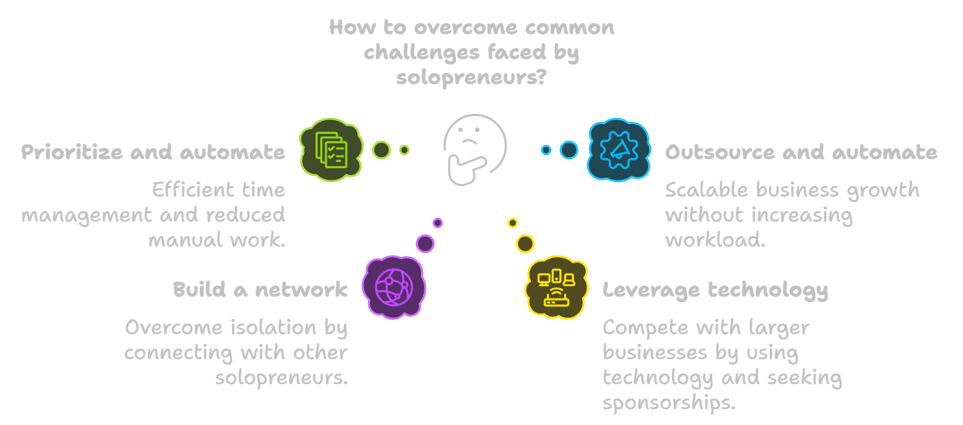

How to Start a One-Person Business
Solopreneurship is an art not everyone is born for. Here are steps to get up and running:
Find / promote your niche and build a business model
The very first thing in launching a solopreneur business is to find your niche. Identify the skills, products, or services you could provide. What matters most to you, and how can you make money from them? You need to choose a niche that aligns with your expertise and meets market demand. Once you know your niche, choose a business model that fits your strengths and lifestyle. Some common solopreneur business models include:
Freelancing: Services like writing, graphic design, consulting, or web development.
E-Commerce: Selling either physical products or digital downloads of goods on online platforms such as Etsy, Amazon, or through your own website.
Content Creation: Creating blogs, YouTube channels, podcasts, or social media content, building an audience, and monetizing through ads or sponsors.
Coaching/Consulting: One-on-one or group sessions on fitness, business, or personal development.
Affiliate Marketing: Earning money by selling other companies' products or services.
Validate Your Business Idea
Make sure there is a demand for your product or service by conducting market research. You can begin by trying your idea out on a small audience or releasing an MVP (minimum viable product) to get some feedback. This validation helps you refine your offer and avoid being in a market that people don’t care about.


Set Up Your Business Structure and Branding
After validating your idea, you have to register your business. Choose a legal structure, like sole proprietorship, LLC, or corporation that suits your need for protection and tax purposes. You will then need to form your business, get licenses and permits, and open a business bank account.
Branding is another critical step in establishing your solopreneur business. Choose a business name, design a logo, and build a visual identity that speaks to your industry and principles. Your branding should resonate with your target audience and differentiate your business from competitors.
Build an Online Presence
As a solopreneur in the digital age, you need to be online. Start by creating a clean, professional website that features your services or products, samples of your work (portfolio), client testimonials, and contact information. You’ll also need to build an identity on platforms where your audience is active. Consider starting a blog or YouTube channel to share valuable content and build credibility in your niche. The goal is to attract clients—having an online presence, building your brand, and generating leads will help you do that.
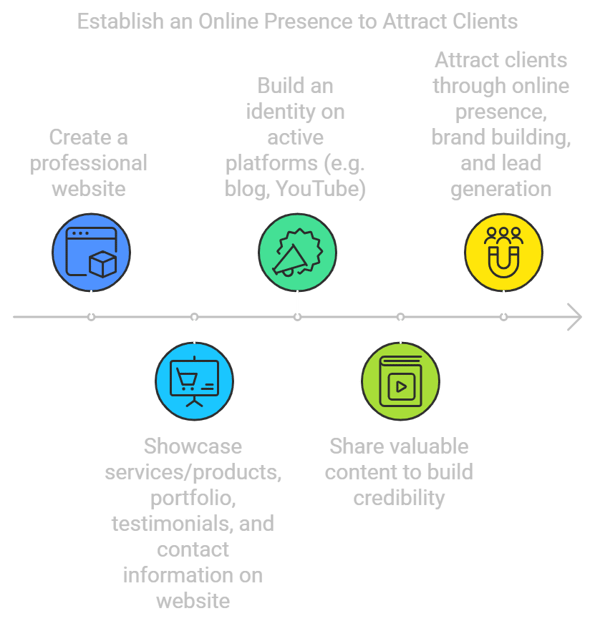

Create Systems and Automate
You need to have systems in place and automate as much of your business as possible so you can manage everything properly. Use tools like Trello or Asana to manage your tasks and QuickBooks for accounting to track your invoices. Tools can streamline your workflow by automating repetitive tasks such as email marketing, invoicing, or social media posting. This process reduces the time and energy spent on routine tasks, allowing you to focus more on growing your business. By automating these processes, you can free up valuable time for yourself, which will become priceless in the long run.
Build a Client Base and Network
Your success as a solopreneur is based on your ability to bring in new clients or customers. Start by utilizing your personal network and offering special deals to build relationships and generate referrals from friends. Networking is essential, whether through online platforms like LinkedIn or local business groups. Focus on delivering quality customer service and building loyalty with your first clients. Satisfied customers are happy to refer your business to others, helping grow your client base through word of mouth.


How to Scale a One-Person Business
There is a method to scaling your solopreneur business. As a solopreneur, scaling comes with unique challenges like managing increased demand without sacrificing quality or burning out. The key to scaling a one-person business is to work smarter, not harder, by streamlining processes, outsourcing tasks, and leveraging technology. Here’s how solopreneurs can scale their businesses the smart way.
Streamline and Automate Processes
You can't grow a business if you are caught up in repetitive and administrative tasks. Automation tools will allow you to manage more clients and more projects without additional work. Now here are some things where automation would help significantly:
Customer Relationship Management (CRM): Tools like HubSpot or Zoho help automate client correspondence, lead tracking, relationship management. This helps you keep track of potential clients and follow up in a timely manner.
Email Marketing: Automate your email marketing campaigns using platforms like Mailchimp, ConvertKit, or ActiveCampaign. Create a series of automated emails to nurture leads, promote new products, or send newsletters without manually sending each email.
Scheduling: Tools like Calendly or Acuity Scheduling allow clients to book meetings or services with you automatically, saving time on back-and-forth communication.
Invoicing and Payments: Automate your invoicing process using platforms like FreshBooks or QuickBooks to ensure that clients are billed on time, and payments are processed efficiently.
By automating these key functions, you’ll free up time to focus on tasks that directly contribute to business growth, such as marketing, strategy, and client relations.
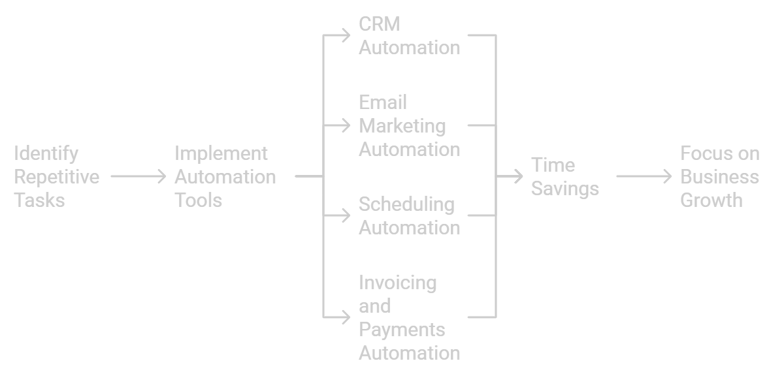

Outsource Non-Core Tasks
As a solopreneur, you don’t need to manage everything yourself. By outsourcing non-core tasks, you can focus on what drives revenue and gives your business a competitive edge. Consider outsourcing:
Administrative Work: Hire a Virtual Assistant (VA) to manage your inbox, schedule meetings, and organize files.
Graphic Design and Web Development: If you’re not a designer or developer, hire freelancers or agencies to create professional branding and websites.
Content Creation: If you need help with blog posts, videos, or social media management, hire content creators or social media managers.
Accounting and Bookkeeping: Invest in a good accountant or bookkeeper to save time and keep your finances in order.
This will free you to work on your business, rather than working in it.
Develop Scalable Revenue Streams
Scaling revenue is a major challenge for solopreneurs because increasing income often means adding more work. To grow sustainably, focus on revenue streams that don’t require more of your time or effort. Here’s how to build scalable income:
Digital Products: Create eBooks, online courses, templates, or software. Digital products offer passive income because, after the initial setup, you can sell them to as many customers as you want without extra work.
Group Coaching or Workshops: If you offer consulting or coaching, transition from one-on-one sessions to group coaching or workshops. This allows you to serve more clients at once, maximizing your time and income.
Affiliate Marketing: Promote other people’s products on your blog, website, or social media and earn a portion of the sales. Affiliate marketing generates passive income without requiring much time investment.
Subscription Services: Offer subscription-based products or services, like membership programs, ongoing support, or exclusive content. Subscriptions provide recurring income and help keep clients engaged over time.
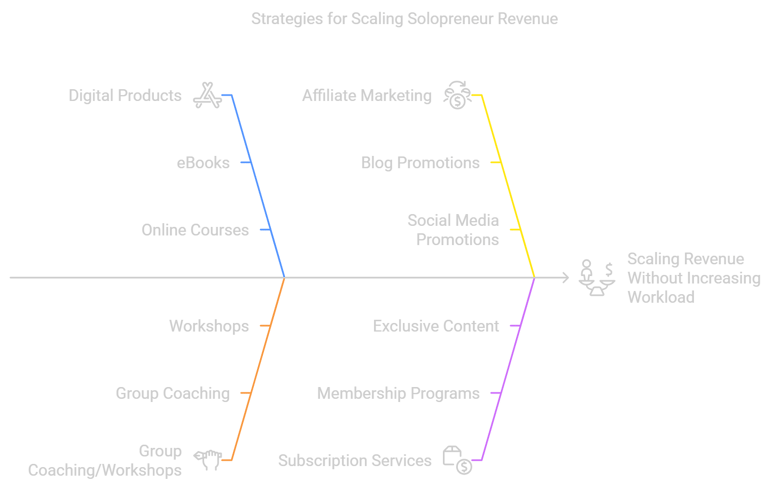

Build Strategic Partnerships
Strategic partnerships allow you to expand your reach and grow faster than you could on your own. Collaborating with other businesses, influencers, or industry experts helps you tap into new audiences and resources. Here’s how to leverage partnerships:
Collaborations: Work with other solopreneurs or small businesses to offer joint services or products. For example, a freelance web designer might team up with a copywriter to provide a full website package.
Affiliate Programs: Create an affiliate program where other entrepreneurs or influencers promote your products or services for a commission. This will help grow your market without extra marketing efforts.
Guest Posts: Write guest blog posts or appear on podcasts in your niche to showcase your expertise and attract new clients. This builds your brand and drives traffic to your website.
Strategic partnerships can help you become more visible and grow your client base faster than going solo.
Focus on Client Retention and Referrals
Clients are the lifeblood of any business, and acquiring new ones can be expensive, especially for solopreneurs. That’s why scaling your business is more efficient when you focus on client retention and referrals. Here are strategies to maintain strong client relationships and encourage referrals:
Provide Exceptional Value: Always over-deliver for your clients in terms of service, results, and customer care. Happy clients are more likely to continue working with you and refer others.
Create a Referral Program: Incentivize clients to refer new business by offering discounts, free services, or other rewards for successful referrals.
Stay in Touch: Regularly communicate with past clients through email newsletters or personalized messages. Even if they aren’t working with you at the moment, staying top of their mind increases the chances of future business or referrals.
Gather Testimonials and Case Studies: Ask satisfied clients for testimonials or case studies that showcase your work. Positive reviews help build trust with potential clients and can be shared on your website or social media.
By nurturing client relationships, you can generate repeat business and turn satisfied clients into advocates for your brand.
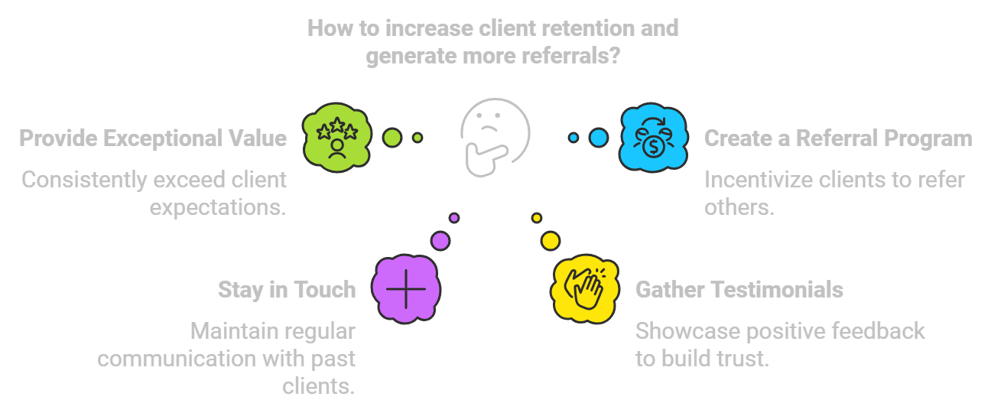

Invest in Personal Development
The more you grow personally, the more your business will follow. To successfully scale your business, it’s essential to continually invest in your skills, knowledge, and mindset. Here are a few ways to do that:
Continuous Learning: Stay informed about industry trends by taking online courses, attending workshops, or reading books related to your niche. Platforms like Udemy, Coursera, and MasterClass offer a variety of courses to help you grow.
Coaching & Mentorship: A business coach or mentor provides the guidance needed to help you set clear goals, overcome obstacles, and map out strategies for growth.
Networking: Connect with fellow entrepreneurs in networking groups, masterminds, or industry associations. Sharing ideas and staying motivated with like-minded individuals can boost your business journey..
Investing in your personal growth will enhance your business skills and give you the confidence and resilience needed to scale effectively.
Case Studies: Successful Solopreneurs
Pat Flynn – Smart Passive Income
Pat Flynn went online as a solopreneur after losing his architecture job in 2008 and has been inspiring millions of online businesspeople ever since. He started this blog called Smart Passive Income where he would write about his journey on the world of online business and how to earn passive income. Pat then built several revenue sources which are affiliate marketing, online courses, and podcaster.
Through personal branding, developing an audience, and establishing portable products, Pat turned Smart Passive Income into a very profitable solo entrepreneurship. Today, he earns a lot of money from his blog, podcast, and online courses that he offers and is a respected figure in the online businessman space.
Key Takeaway: Focus on creating scalable income streams, such as digital products and affiliate marketing, to grow your solopreneur business without trading time for money.
Marie Forleo – Marie Forleo International
Marie Forleo started her solopreneur journey as being a life coach who worked with clients on a one-on-one basis. And so, over the years she noted that exchanging time for money certainly was not useful when one wanted to expand her/his business. Marie then started developing online courses, and she launched B-School which is an online business program that assists people in growing their businesses.
It can be noted that Marie has chosen digital product sales and constructing her own persona as the ways to expand the business many times. She now runs a multimillion company that is nearly staff-less with only a few employees who are always outsourced and there is a lot of automation.
Key Takeaway: Transition from one-on-one services to scalable offerings like online courses to reach a larger audience and grow your solopreneur business.
Conclusion
The emergence of solopreneurship can be viewed as a paradigm shift in the way the involved parties do business. With the right stategies, achieving a solopreneur’s dream of running a one-person business that is simple, independent, and lucrative is very much possible.
For solopreneur business success, it is recommended that ideas should be niche, automation and outsourcing should be employed, tangible and passive incomes should be pursued and customers should be valued. If you would like to expand your business and have a healthy work-life balance as a solopreneur, the best practices outlined by other solopreneurs in this article should serve you well.
With technology advancement and the increased use of the gig economy, there will be numerous ways for solopreneurs to find new creative solutions and growth paths. From the newbie or still in your initial stage up to that person who wants to step it up and make a business out of it, I say the future is bright for solopreneurs and anyone who wants it should grab the opportunity.
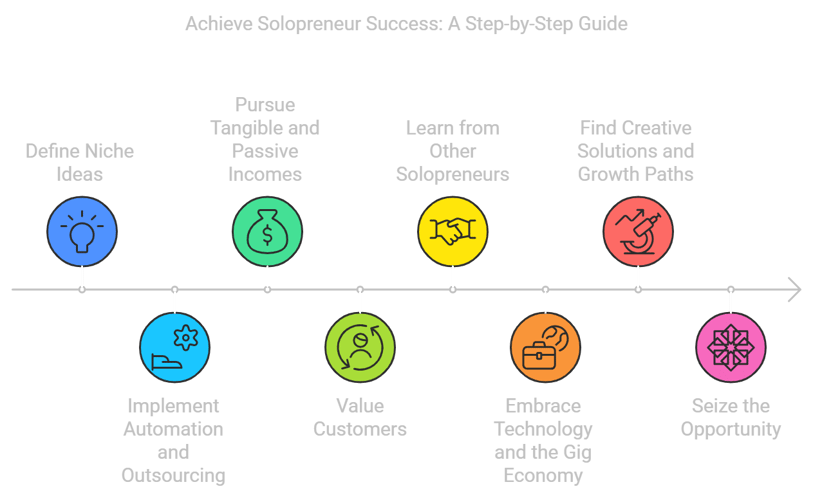

© 2025 Bogdan Antihi. All Rights Reserved.
Follow me on
Let’s Make AI Work for You




